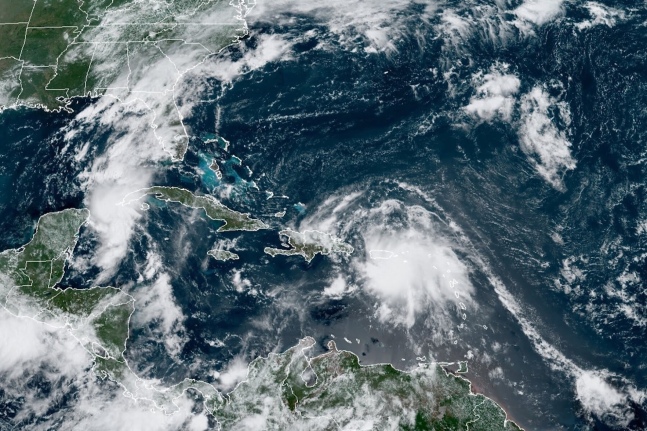By Derrick Bryson Taylor’s
Aug. 22, 2020, 1:59 p.m. ET
Marco is expected to become a hurricane on Saturday and Laura is forecast to produce heavy rain over several Caribbean islands.
Tropical Storms Marco, left, and Laura, right, are churning in the Caribbean. A forecaster described Marco as “looking pretty organized.”NOAA
Tropical Storms Marco and Laura continued to churn in the Caribbean on Saturday, prompting a wave of warnings and watches for several countries, and leading the governor of Louisiana to declare a state of emergency.
Marco on Saturday was 105 miles east-northeast of Cozumel, Mexico, with maximum sustained winds of 65 miles per hour, the National Hurricane Center said on Saturday morning.
“It’s looking pretty organized,” said Joel Cline, tropical program coordinator for the National Weather Service. “It’s expected to become a hurricane later today or tonight.”
Mr. Cline said it was possible that both storms would become hurricanes in the Gulf of Mexico as early as Monday. He added that it would be “pretty unusual” and that the last time it happened was in 1933. The last time a hurricane and a tropical storm were both in the Gulf of Mexico was in 1959, he said.
Dennis Feltgen, meteorologist with the National Hurricane Center, on Friday squashed social media speculation that the storms would collide forming a single monster storm. “They cannot merge,” he said. “They actually repel each other because of the rotations.”
Marco may strengthen over the next two days but begin to weaken by Monday or Tuesday, the center said. The storm was expected to produce from one to four inches of rain, with some isolated amounts of six inches, across the eastern portions of Mexico, forecasters said.
In response to Marco, the government of Cuba issued a tropical storm warning for the province of Pinar del Rio, the center said. A tropical storm warning was also in effect for Cancun to Dzilam, Mexico.
“By late in the day on Monday, it should be very, very close to Louisiana, Texas coastlines, and probably go down to a tropical storm at that time,” Mr. Cline said of Marco.
On Saturday morning, Laura was about 20 miles southwest of Ponce, Puerto Rico, with maximum sustained winds of 40 m.p.h., according to the hurricane center.
The center of Laura was forecast to move near Puerto Rico on Saturday morning, near Haiti and the Dominican Republic by Saturday afternoon and night and then near eastern Cuba by Sunday.
Mr. Cline said Laura was “disorganized.” As long as it’s moving over those islands, he said, “then no intensification is expected to happen.”
However, Laura was expected to produce three to six inches of rain in Puerto Rico and the U.S. Virgin Islands, with some areas seeing as much as eight inches, the hurricane center said. Cuba was expected to receive similar rainfall amounts. The Dominican Republic and Haiti may see up to eight inches of rain, with as much as 12 inches across the southern areas.
Tropical storm warnings were in effect for Puerto Rico, the U.S. Virgin Islands, Turks and Caicos, and certain areas of the Dominican Republic, Haiti and the Bahamas. A tropical storm watch was issued for the central Bahamas and portions of Cuba.
When Laura reaches the Gulf of Mexico, it may strengthen, Mr. Cline said.
Gov. John Bel Edwards of Louisiana on Friday declared a state of emergency.
“Louisiana is in a unique situation being in the cone of two storms, which could impact different areas in the coming days,” Mr. Edwards said. “It is too soon to know exactly where, when or how these dual storms will affect us, but now is the time for our people to prepare.”
Declaring a state of emergency allows the state to help local governments with their preparations, Mr. Edwards said. He advised Louisiana residents to include face masks and hand sanitizer in their emergency kits. “Covid-19 does not become less of a threat because of tropical weather,” he said.
This year’s hurricane season is expected to be one of the most active on record, the National Weather Service has said.
The National Oceanic and Atmospheric Administration this month updated its forecast for the remainder of this year’s season, estimating that by the time the hurricane season is over on Nov. 30, there will have been up to 25 named storms.
Seven to 11 of the named storms could become hurricanes with winds at 74 m.p.h. or more, including three to six major hurricanes during the season, NOAA scientists said.
Even with a forecast of up to 25 named storms, meteorologists still do not expect a season as active as the one in 2005, which had 28 named storms.
The 2020 Hurricane Season
Derrick Bryson Taylor is a general assignment reporter on the Express Desk. He previously worked at The New York Post’s PageSix.com and Essence magazine.
No comments:
Post a Comment